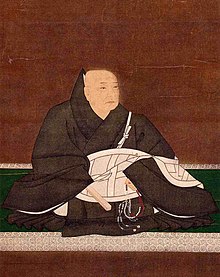Rennyo

Rennyo ( Japanese 蓮 如 ; * February 25, 1415 in Kyōto ; † March 25, 1499 in Yamashina-ku , Kyōto) was a descendant of Shinran -Shōnin in the 8th generation and reformer of the Jōdo-Shinshū -direction of Buddhism during the Muromachi period .
Life
Rennyo, eldest son of Zonnyo (存 如; posthumously Enken Hōshi), was adopted by Chūnagon Kanesato (中 納 言 兼 郷). At the age of 16 he became a monk in the Hongan-ji Temple under the name Kenju (兼 壽), but was generally called "Chūnagon-Hōshi". His reputation as a kind of saint and as an excellent speaker aroused the envy of the monks of Enryaku-ji Monastery , which led to his having to leave Kyoto. After he had wandered through the eastern provinces to Echigo preaching, he returned to Kyoto, claimed the leadership of the Hongan-ji and in 1457 became abbot of the temple. Shortly afterwards he was received by Emperor Go-Hanazono , who had visited him in the temple at his own expense. This favor so angered the monks of Enryaku-ji that they set the Hongan-ji on fire. Rennyo was just able to escape, taking the statue of Shinran with him and saving it.
He resumed his wandering life, built temples in Chikamatsu in the province of undmi and in Yoshizaki in the province of Echizen the Yoshizaki Gobō (吉 崎 御 坊). He had already been working in Yoshizaki for five years when the monks of the Senju-ji (専 修 寺) temple of the Takada branch of Shinshu became jealous of his successes. They attacked the temple in 1475 and completely destroyed it. Rennyo set off again and founded the temples Kōzen-ji (光 善 寺; Kawachi ), Kyōgō-ji ( Settsu ) and Shinshū-ji (Kawachi).
Then in 1480 he selected the village of Yamashina (山 科; Yamashiro ) as the location for the reconstruction of the Hongan-ji. There he died at the age of 85. His direct successor received the title Monzeki in 1521. Rennyo himself was posthumously honored in 1882 with the title "Etō Daishi" (慧 燈 大師). His descendants in the Meiji period, the abbots of Hongan-ji, now divided into an East and West temple, were the Counts dietani.
Act
Rennyo helped Yōdo-Shinshū to achieve a breakthrough by spreading its teachings of the redemption of Buddha Amida (Sanskrit: Amitabha ) in all sections of the population and many geographical regions of Japan in a time torn by wars ( Ōnin war ) and conflicts. Volker Zotz judges: "If you think in terms of the number of followers and the creation of permanent institutions, Rennyo is undoubtedly one of the most successful Buddhists." For this reason, he received the honorary title Rennyo Shōnin ( 蓮 如上 人 ).
Like the apostle Paul on his Christian mission , Rennyo made effective use of the letters (gobunsho) that he sent to followers in all parts of the country in order to spread his Buddhist teachings. Rennyo is also seen as a pioneer for the betterment of women in society and religion. Rennyo, even more than Hōnen and Shinran in numerous letters, dedicates himself to this concern of the redemption of women from suffering or their entry into the Pure Land . According to Rennyo, Amida was particularly dedicated to saving women in the 35th Vow ( Great Pure Land Sutra ).
For Europe, Harry Pieper (1907–1978) was the first Buddhist to place elements of Rennyo's teaching at the center of religious practice by letting his students recite his confessional formula Ryōgemon . This confessional formula expresses that one wants to abstain from all exercises except the recitation of “Namu Amida Butsu” in order to rely solely on the rescue through the Buddha Amida in the spirit of Shinran.
literature
- Harry Pieper : Buddhist Devotions and Celebrations. German form. Kyoto (Honpa Hongwanji Press) 1958.
- Minor L. Rogers: Rennyo. Berkeley 1991, ISBN 0-89581-930-9
- Volker Zotz: The Buddha in the Pure Land. Shin Buddhism in Japan. Munich 1991, ISBN 3-424-01120-7
- Shojun Bandō, Harold Stewart, Ann T. Rogers, Minor L. Rogers (trans.): Tannishō: Passages Deploring Deviations of Faith and Rennyo Shōnin Ofumi: The Letters of Rennyo , Berkeley: Numata Center for Buddhist Translation and Research 1996. ISBN 1 -886439-03-6
- Mark L. Blum and Yasutomi Shin'ya, ed. (2006): Rennyo and the Roots of Modern Japanese Buddhism. Oxford University Press
- Jérôme Ducor (1998). La vie de Rennyo (1415-1499) ; The Rennyo Shônin Reader (ed. By Institute of Jodo-Shinshu Studies and Hongwanji International Center; Kyôto, Jôdo-Shinshû Hongwanji-ha International Center, 1998), p. 57-90.
- Elson Snow, trans. (1994). Goichidaiki-kikigaki: Sayings of Rennyo Shonin , Pacific World Journal, New Series, Number 10, 1-55.
- Edmond Papinot: Rennyo . In: Historical and Geographical Dictionary of Japan. Reprint of the 1910 edition. Tuttle, 1972, ISBN 0-8048-0996-8 .
Individual evidence
- ↑ Volker Zotz: Rennyo after 500 years. On the topicality of a Buddhist master of the Muromachi period. News of the Society for Nature and Ethnology of East Asia, Hamburg, 163–164, 1998, pp. 5–21, ISSN 0016-9080 .
Web links
- Literature by and about Rennyo in the catalog of the German National Library
| personal data | |
|---|---|
| SURNAME | Rennyo |
| ALTERNATIVE NAMES | 蓮 如 (Japanese); Rennyo Shōnin (honorary title); 蓮 如上 人 (honorary title, Japanese) |
| BRIEF DESCRIPTION | Renewer and head of the Jodo Shinshu |
| DATE OF BIRTH | February 25, 1415 |
| PLACE OF BIRTH | Kyoto |
| DATE OF DEATH | March 25, 1499 |
| Place of death | Yamashina-ku, Kyoto |
